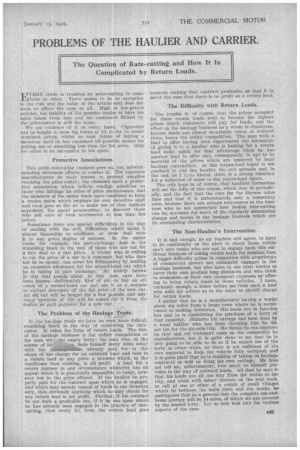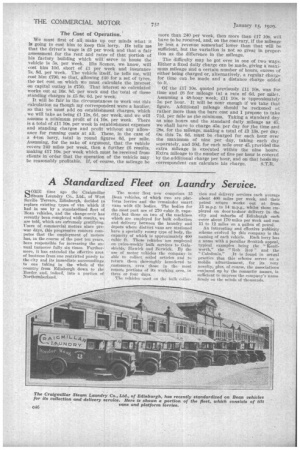PROBLEMS OF THE HAULIER AND CARRIER.
Page 29

Page 30

If you've noticed an error in this article please click here to report it so we can fix it.
The Question of Rate-cutting and How It Is Complicated by Return Loads.
"1:41-VERY trade is troubled by price-cutting ia some 1 form or other. There seems to be no exceptiou to the rule and the value of the article sold does not wen:to affect the case at all, High or low-priced articles, the liability of the genuine trader. to have his sales •taken from him. and his customers filched by
the price-cutter is still the same. • We see evidence of it on every hand. Cigarettes ean be bought in most big towns at lit. in the 1s. under standard prices, whilst no man thinks of buying a motorcar until he has examined all possible means for getting one at something less than the list price. Only too often is he successful in his quest.
Protective Associations.
This profit-destroying business goes on, too, notwithstanding strenuous efforts La combat it. The cigarette manufacturers do their utmost to prevent supplies reaching the price-cutter ; the chemists have a protective association which inflicts" condign penalties on those who infringe its rules of price maintenance, and the members of the motor trade have combined to form a trades union which employs its own •detective staff
and even goes so far as make use of that dubious expedient, the agent provocateur, to discover those who sell cars or even accessories at less than list prices. .
Sometimes there are special difficulties in the way of dealing with the evil, difficulties which make. it almost impossible to eradicate or even deal with It to any great degree of success. In the motor trade, for example, the part-exchange deal is the stumbling block in the way of those who are out for a fair deal at a fair price. A" trader who is. willing to cut the price of a car to•a customer, but who dare not do so openly, can covet his delinquency by making an excessive alloWance. for the second-hand "ear. which he is taking in part exchange. So widely known is this • that peciplei about to buy new cars have been known—deliberately, first" of • all—to. bitY an 'old crock of a second-hand car and use it as .11,-weapon to extract discounts Off the list Priee" of the new car. An old car will be bought for a few pounds, and any. thi,ig-upwards of gig will he asked for it from tin. dealer ..tts" part payment for a new -car: The Problem, of the Haulage Trade.
lu the hablage trade we have an even More difficult stumbling block in the way of countering the ratecutter. It takes the form of return loads. The ruin of the haulage business is the unfair competition of the man wit the empty lorry ; the man who, In the
course of hi: •'"f finds himself many miles away
with the j already paid for in the shape of his charge for an outward load and sees in a return load at any price a revenue which, in the conditions then existing, Is all profit. A lead for a return journey in any circumstance whatever has an appeal which it is practically impossible to resist, however low be the price offered. If the haulier be properly paid for the Contract upon which he is engaged, and which may merely consist of loads in one direction only, then obviously anything which he may obtain for any return load is net profit. Further, if hiscontract he not such a profitable one, if it be one upon which he has already been engaged in the practice of ratecutting, then every hi. from the return load goes towards making that contract profitable, so that it is never the case that there is 110 profit on a return load.
The Difficulty with Return Loads.
The trouble is of course, that the prices accepted for these return loads tend to become the highest prices which customers will pay for loads, and the effect on the haulage business as a whole is disastrous. Return loads are almost invariably taken at reduced rates, hence the unfair competition. The man with a load to offer having once experienced the advantagh of giving it to a haulier Who is looking for a return load looks again for that advantage when he has .another load to Offer and, consequently, is apt to be scornful 'of • I.he prices, which are tendered by local haulage contractors. As this return-load bogey is not confined to any One locality the evil spreads and, in the end, as I htty4 hinted, there is a strong tendency for a reduction of rates to the return-load figure.
The only hope is, of course, that hauliers themselves will See the folly of this course, which they do periodically, and the fact that the cure for the ,disease takes time and that it is unfortunately only a temporary cure, because there are always newcomers to the business who do not appreciate how foolish rate-cutting can be, accounts for much of the regularly alternating slumps and .booms in the haulage business which are its outstanding characteristics.
The Non-Haulier's Intervention.
It is bad enough, as my readers will agree, to have to be continually on the alert to check those within one's own ranks who are apt to engage upon this cutthroat business of taking return loads for nominal fees. A bigger difficulty arises in connection with proprietors of commercial motors not ordinarily engaged in the haulage business, but who have to use their lorries to carry their own produce long distances and who think to economize on their own transport expenses by offering to bring return loads in those vehicles., I have, curiously enough, a letter before me from such a user who asks my advice as to the rates he should charge for , return loads.
I gather that he is a manufacturer having a works about six miles from a large town where he is accustomed to making deliveries. His loads are in four-ton lots and lie is considering the purchase of a lorry of that capacity. Hitherto his cartage has been done by a local builder who has been charging him 611. 6d. per ton for the six-mile:trip. He-thinks he can improve on that and, cut transport Costs on the commodity he manufactures, but it is quite 'clear to me that he is only going to be able to do so, if he makes use of the lorry in other. ways; as there is not sufficient Of his own material to keep the vehicle fully occupied, and It is quite plain that he is thinking of taking on haulage contracts is well as doing his own cartage. He does not tell me, unfortunately, how ranch he himself provides in the way of outward loads. All that he says is that his loads are all one way from the works .to the city, and what with minor detours on the way back, to call at one or other of a couple of small villages which lie between the main town and the works, he anticipates that as •a general rule the complete out-andhome journey will be 14 miles, of -which six are covered by the loaded lorry. Let us now, look into the various aspects of the case. The Cost of Operation.
We must first of all make up our minds what it is going to cost him to keep thi lorry. He tells me that the driver's wage is £.3 per veek and that a fair assessment for the rent and rates of that portion of his factory building which will serve to house the vehicle is 5s. per week. His licence, we know, will cost him 10d. short of £1 per 'week and insurance 7s. 8d. per week. The vehicle itaelf, he tells me, will cost him £780, so that, allowing £40 for a set of tyres, the net cost on which we must calculate the interest on capital outlay is £750. That interest so calculated works out at 16s. 8d. per week and the total of these standing charges is 15 8s. 6th per week. It will be fair in the circumstances to work out this calculation a's though my correspondent were a haulier, so that we must add on establislttnent charges, which we will take as being £1 us. 6d. per week, and we will assume a minimum profit of 14. 10s. per week. There is a total of £11 1.0s. per week in-es ablishment expenses and standing charges and profit without any allowance for running costs at all. These, in the case of a 4-ton lorry, total in round figures 6d. per mile. Assuming, for the sake of argument, that the vehicle covers 240 miles per week, then a further 16 results, making £17 108. per week which must be received from clients in order that the operation of the vehicle may be reasonably profitable. If, of course, the mileage be
more than 240 per week, then more than £17 10s. will have to be received, and, on the contrary, if the mileage be less a revenue somewhat lower than that will be sufficient, but the variation is not so great in proportion as the difference in the mileage.
The difficulty may be got over in one of two ways. Either a fixed daily charge can be made, giving a maximum mileage and a certain number of hours, excess of either being charged or, alternatively, a regular charge for time can be made and a distanee charge added to it.
• Of the 1.17 10s. quoted previously 10s. was for time and £6 for mileage (at a rate of 6d. per mile).
Assuming a 48-hour week, 10s. is approximately 5s. per hour. It will be near enough if we take that figure. Additional mileage should be reckoned at rather more than the bare cost and I propose to take 7id. per Mile as the minimum. Taking a standard day as nine hours and the standard daily mileage as 45, we shall have to charge 45s. per day for the time and 28s, for the mileage; making a total of £3 13s. per day. On this 75. 6d, must be -charged for each hour over the maximum of nine per day, taking each day eparately, and 10d. for each mile over 45, provided the extra mileage is executed within the nine hours. Extra mileage to the number of five per hour is covered by the additional charge per hour, and on that basis my
correspondent can calculate his charge. S.T.R.
































